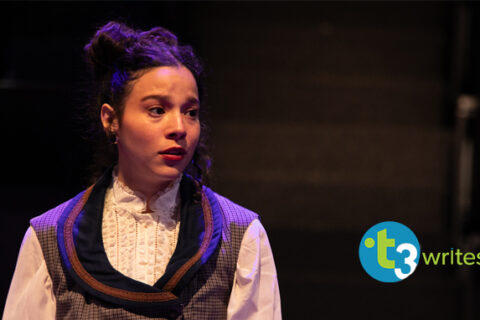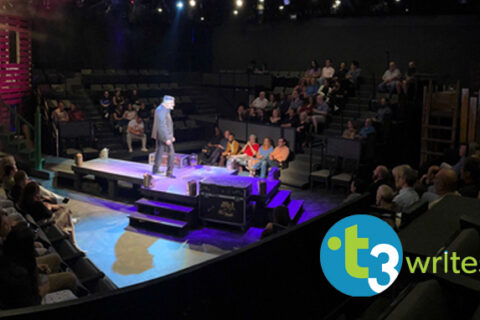Researching, Rehearsing, and Traveling through Time and Place
by Elly Lindsay with introduction by Kat Edwards
Theatre artists don’t get enough credit for the level of intellectualism involved in creating a character and the world that they live in onstage. More often than not, the perception is that actors just learn these lines and suddenly exist in this world as a new person and like what even is a designer? But, I mean, come on, Doctor. How’d you get to be a doctor? Did you go to school for years and years where they taught you the things that you needed to know to be a doctor? Did you get to do a bunch of labs where you used pretend or substitute tools and body parts to simulate the real thing? Did you follow someone around and get to learn about bedside manner in real time? Congrats! You have researched and rehearsed your role in this world – something that practicing theatricians do all the time, over and over again.
Elly Lindsay shines as Annie Nations in Theatre Three’s production of Foxfire, a play that is rich in history. On top of being a talented actor, Elly’s performance was well researched. So, learn a little something from this week’s post as Elly Lindsay sets the stage for you.
…
One of the interesting demands of certain plays and roles is the need to do research. Any period piece – meaning not set in the present but in a time past – requires understanding what was happening in the current culture. What was the clothing like, what were household goods like?
Foxfire provided a marvelous opportunity for various kinds of research. Although the present day of the play is 1982, the flashback scenes take us to 1920, 1945, 1961 and 1977. Also, the play is based on the Foxfire magazines that were created by high school students in the 1960’s and 70’s. Elliot Wiggenton, an English teacher, was looking for a way to engage his students and he suggested that they go out into the community and interview the older people to find out what life had been like. The result was a chronicling of Appalachians crafts, music, stories of their way of life. Many lines of dialogue in the play come directly from the magazines which were compiled into a set of books.
Annie Nations, the character I play, is based primarily on Aunt Arie, who became a favorite with Foxfire readers. She was an indomitable woman with a huge smile. The first time the students went to interview her she was taking the eyes out of a hog’s head. The scene in the play with the pig head comes directly from that real-life interaction.
Research used to mean heading to the library and checking out books. Or maybe renting a movie set in the same time and place. Today the internet has changed all that. I still went to the library and checked out one of the Foxfire Books. Some of the useful things I found were maps of different homesteads that showed where the barn, the root cellar, the smoke house, the garden – and of course the outhouse- were placed. There are references to all of these in the play. Dillard askes “What happened to the smoke house?” (where they would have smoked meat to store it). Annie answers that “The roof give up”. Later she tells Dillard to put oranges in the cellar – which would be the root cellar which kept vegetables and fruit cooler and allowed them to last longer.
A chapter I found particularly interesting was one on the Chestnut Blight which destroyed all the chestnut trees throughout the east coast. The fungus which caused the blight was introduced in 1904 and by the early 40’s, most of the American Chestnuts were wiped out. This was particularly hard on the farmers of Appalachia. Chestnut wood was strong and used for a lot of building. It was easy to sell and trade. The nuts were used as feed for animals and also something that could be sold or traded. One of the things that the farmer’s turned to as the chestnuts disappeared was making and selling moonshine. There are references to Hector Nations trading in the 1930’s when he and Annie had a young family and that one of the commodities, he traded was corn liquor – or moonshine. Hector and Annie’s life would have been severely affected by the blight.
As Annie, there was some other research I needed to do. Although I have given birth (I have a 33-year-old son), it has been awhile. Fortunately (or maybe not) you can find almost anything on You Tube – so I watched scenes from movies and TV shows which involved the moments before birth. And of course, I have never cleaned a pig head and again, You Tube was what I turned to. The scraping moments with the knife came directly from one of those videos.
The one thing I didn’t have to research was the little dance Annie does in the courting scene in 1920. I have done English and American traditional dancing since I was 9, including Appalachian Squares and clogging. For the past 18 years my husband and I have spent the time between Christmas and New Year’s in Berea, KY at a festival that celebrates that kind of music and dance as well as some of the crafts.
Research is one the fun responsibilities of an actor. I have told friends that I haven’t traveled that much in the actual world, but I have traveled deep in time and place when I enter into the world of a play – Nazi Germany and post war England for Kindertransport by Diane Samuels; South Texas and my husband’s family for Trip to Bountiful by Horton Foote; Gettysburg, Pennsylvania for John by Annie Baker, and the beautiful Stoney Lonesome, Georgia in Foxfire by Susan Cooper and Hume Cronyn.
…
Book and Lyrics by Susan Cooper and Hume Cronyn • Music by Jonathan Holtzman • Directed by Emily Scott Banks
Run Dates: March 14 – April 7, 2019


